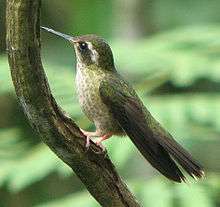Speckled hummingbird
| Speckled hummingbird | |
|---|---|
 | |
| Scientific classification | |
| Kingdom: | Animalia |
| Phylum: | Chordata |
| Class: | Aves |
| Order: | Apodiformes |
| Family: | Trochilidae |
| Genus: | Adelomyia Bonaparte, 1854 |
| Species: | A. melanogenys |
| Binomial name | |
| Adelomyia melanogenys (Fraser, 1840) | |
The speckled hummingbird (Adelomyia melanogenys), is a species of hummingbird. It inhabits Neotropical montane cloud forests at elevations of 1,000–2,500 meters and found in Argentina, Bolivia, Colombia, Ecuador, Peru, and Venezuela.
Description
The speckled hummingbird is a monomorphic species, making females and males indistinguishable. Adults measure approximately 8 cm, or 3 inches, in length (from bill to tip of tail). The upper plumage is a glossy green/bronze. The underside is pale, with green and bronze specks.[2] It has a black cheek patch below its eye with a white stripe above.
Its nest is a hive-like structure made from moss and other organic materials, hung on the underside of a fern or tree.
While the speckled hummingbird is the only species in its genus, evidence suggests that populations on either side of the Andes mountains are genetically distinct.[3]
Behavior
The speckled hummingbird is a solitary species in all behaviors. They neither live nor migrate in flocks and there is no pair bond for this species.[2]
Breeding
Males do not participate in the any part of nest building or brooding of the young, and disengage with female partners after copulation. Though, both males and females may be promiscuous, having multiple partners.[2]
Female speckled hummingbirds incubate and feed nestlings. The incubation period lasts approximately 17–20 days.[4] The species broods for shorter durations than most hummingbirds during incubation. Speckled hummingbirds often travel several kilometers to avoid competition, making visits to the nest less frequent. After the young hatch, the adult continues brooding hatchlings for 7–8 days.[4] After brooding and until the young have fledged, the adult will no longer enter the nest and instead perches nearby, potentially watching for predators.[4] This behavior is curious, as perching outside a nest may alert predators of its location.
Diet and feeding
The species does not gather with others to feed, even at flowering trees. Speckled hummingbirds feed on the nectar of flowers, often near the ground, either from short-tubed flowers or holes at the base of long-tubed flowers.[5] Like other hummingbird species, it is likely that the speckled hummingbird will also feed on insects, for additional nutrients.[6] The species may also collect small insects that are caught on or in the nest.[4]
References
- ↑ BirdLife International (2012). "Adelomyia melanogenys". IUCN Red List of Threatened Species. Version 2013.2. International Union for Conservation of Nature. Retrieved 26 November 2013.
- 1 2 3 Web, Avian. "Speckled Hummingbirds". Beauty Of Birds. Retrieved 2016-01-11.
- ↑ Chaves, Jaime A.; Pollinger, John P.; Smith, Thomas B.; LeBuhn, Gretchen (2007-06-01). "The role of geography and ecology in shaping the phylogeography of the speckled hummingbird (Adelomyia melanogenys) in Ecuador". Molecular Phylogenetics and Evolution. 43 (3): 795–807. PMID 17208464. doi:10.1016/j.ympev.2006.11.006.
- 1 2 3 4 Wetherell, E.; Port, J.; Greeney, H.F. (2015). "Breeding biology of Speckled Hummingbird Adelomyia melanogenys in eastern Ecuador" (PDF). Cotinga. 37: 43–46.
- ↑ Ridgely, Robert S.; Greenfield, Paul J.; Gill, Frank (2001-06-26). The Birds of Ecuador: Field Guide (First ed.). Ithaca: Cornell University Press. ISBN 9780801487217.
- ↑ Ornelas, Juan Francisco (2010-09-01). "Nests, Eggs, and Young of the Azure-crowned Hummingbird (Amazilia cyanocephala)". The Wilson Journal of Ornithology. 122 (3): 592–597. doi:10.1676/09-155.1.
External links
| Wikimedia Commons has media related to Speckled hummingbird (Adelomyia melanogenys). |
- Speckled hummingbird videos on the Internet Bird Collection
- Speckled hummingbird photo; Article pbase.com
